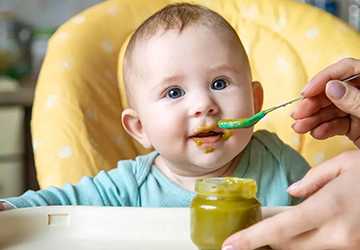What to Do When Your Baby is Teething?
Teething marks a critical period in a baby's development and can be both exciting and challenging for parents and babies. When teething symptoms occur, finding remedies and strategies to help your baby becomes crucial. This guide is designed to help you recognize symptoms, find relief, and ensure your teething child is comfortable.

Interpreting the signs of teething in babies
Symptoms of teething in babies vary widely. However, several general indicators can indicate the onset of teething:
● Increased drooling: The onset of teething often triggers increased saliva production in babies. This drooling is a natural response to the sensation and development of your gums. Not only does excess saliva help soothe the gum area, but it is also thought to be a preparatory function of the digestive system for the eventual absorption of solid food.
● Seek relief through chewing: Babies naturally seek comfort by chewing on complex objects during teething. This behaviour allows them to exert pressure on the gums, counteracting the discomfort caused by the emergence of new teeth. Using objects like teething toys, spoons, or even fingers can provide the pressure needed to relieve pain.
● Fussiness: Teeth protruding from the gums, along with pressure and inflammation, may cause significant discomfort and pain to the baby. This pain manifests as periods of irritability or mood swings, which are a direct response to the pain they endure during this period.
● Visible gum swelling: When teeth push through the gums, the affected area may swell and become more sensitive due to inflammation. This swelling is expected during teething and represents the body's natural response to tooth development.
● Slight increase in body temperature: Some babies often experience a slight increase during teething but stay below 101 degrees Fahrenheit. It's important to know that a true fever is usually unrelated to teething and may indicate an illness or infection that requires evaluation by a doctor.
● Recognizing these symptoms and expected teething elements means your baby's growth is proceeding as expected. Although teething can be challenging for babies and their caregivers, knowing the signs will allow you to provide appropriate support and intervention to ease your baby's discomfort.
Awareness of these signs will help you support your baby skillfully during these difficult times.
Ease the Discomfort: Remedies for Teething Kids
It's essential to find practical baby teething treatments to ease the discomfort of a teething baby. Here are some proven strategies:
Cold press
● Use a fresh, damp cloth that has been chilled in the refrigerator. Gently press it against your child's gums for a soothing effect.
Bite device
● Choose teething toys made of sturdy rubber. These toys provide the counter-pressure needed to relieve gum pain.
Solid snacks
● If your child eats solid foods, it may be helpful to provide cold peeled vegetables (such as cucumbers or carrots) for him to chew. Continuous supervision is essential to prevent the risk of suffocation.
Gum massage
● Massaging your baby's gums with sterilized fingers can relieve pain, a simple yet effective solution.
Engaging in Distraction Strategies
Interactive Engagement
Distracting your child with gentle, stimulating activities can distract him or her from the pain of teething. Playing with interactive toys, singing soothing tunes, and gentle massage can provide temporary comfort by diverting their attention.
Soothing ambient melodies
Soft background noise or soft melodies can soothe a teething baby. Playing sounds reminiscent of the intrauterine environment, white noise, or gentle lullabies can also help calm your baby.
Nutritional assistance
● High-calcium foods: For babies who have started eating solid foods, adding calcium-rich foods, such as pureed vegetables, can promote dental health. Calcium plays a vital role in the formation of teeth and strengthens them as they grow.

● Ensure you're hydrated: It's crucial to ensure your teething child gets enough fluids, especially if they drool excessively. Breast milk, formula, or water (for babies six months and older) can prevent dehydration and keep gums moist.
Support teething babies
Knowing how to help a teething baby involves more than just remedies. It's about creating an environment and routines characterized by comfort and care during this stage.
Consistent routine
● A stable routine is essential to giving your baby a sense of security and peace of mind.
Improve relationship
● The discomfort of teething may require extra tenderness and cuddling on your part.
Professional advice
● If your baby is experiencing severe discomfort or you are concerned about teething, it is recommended that you consult a paediatrician. They can provide you with guidance and safety while your baby is teething.
Create a pleasant atmosphere.
● Creating a calming atmosphere with soft music, gentle rocking, and dim lights can significantly calm your teething baby.
A safe atmosphere to explore
● Toddler Safety: Since toddlers tend to chew on just about anything they can reach when teething, creating a safe environment is crucial. Always child-proof your home to remove small, solid objects that could pose a choking hazard.
● Supervised exploration: Allowing your baby to explore different textures under careful observation can also help ease the discomfort of teething. Safe, child-friendly objects that can be manipulated, touched, and chewed can provide educational value and comfort.
By combining these strategies with close observation of their baby's needs and preferences, caregivers can more easily and safely navigate the teething phase.
Conclusion
Treating baby teething symptoms requires patience, love, and appropriate remedies. Knowing how to help a teething baby can make life easier for you and your child during this critical developmental period. It's important to remember that every toddler is unique. What works for one person may not work for someone else. The key is to find the perfect combination of comfort, attention, and solutions to support your child through their teething journey.







